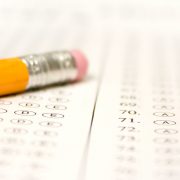Every October, schools offer the PSAT/ NMSQT to students nationwide. We get a lot of questions about this test, so to help, we’ve put together everything you need to know in this PSAT guide.
Who takes it?
The PSAT/NMSQT is typically offered to 11th grade students. Juniors who take the PSAT/NMSQT compete for the coveted National Merit Scholarship (keep reading for more on the scholarship). While some schools may allow 10th grade students to take the October PSAT/NMSQT, most 10th graders will instead have the opportunity to take the PSAT 10 sometime in the spring.
What’s the difference between the PSAT/NMSQT and the PSAT 10?
You may have heard of an alternative called the PSAT 10. The PSAT/NMSQT and the PSAT 10 are the same test but are offered at different times of the year. The PSAT/NMSQT is open to 11th grade students and (depending on your school) 10th grade students and is used as a qualifying test for the National Merit Scholarship. The PSAT 10 is open only to 10th grade students. Although some scholarship programs use the PSAT 10 to screen for qualified students, the test does NOT qualify students for the National Merit Scholarship.
PSAT/ NMSQT and PSAT Test Dates 2025/2026
PSAT/NMSQT Test Dates |
PSAT 10 Test Dates |
| PSAT/NMSQT testing may occur on a school day between these dates: October 1–October 31, 2025 Schools may also choose to administer the PSAT/NMSQT on Saturday, October 11, 2025. |
Schools choose a date between March 2- April 30, 2026 |
Why should you take the PSAT/NMSQT?
Many students take the PSAT/NMSQT for the opportunity to compete for the National Merit Scholarship and other scholarship and recognition programs. This is a great reason to take the test, but there are other reasons to sit for it, including:
- Overcoming test anxiety: The PSAT gives you a chance for some SAT practice under realistic testing conditions, which can help reduce testing anxiety by building confidence.
- Feedback for SAT success: The feedback you receive from the PSAT can help identify areas of strength and weakness to aid you in your SAT prep.
- Seeing how you compare: Percentile rankings on the PSAT can provide insight on how your scores compare to your peers nationwide, which can help guide your college admission strategies.
What is the National Merit Scholarship?
The National Merit Scholarship program began in 1955. Since then, it has become known as one of the most prestigious academic awards a student can earn – and with good reason: Just a small percentage of test takers will become finalists in the competition.
The scholarship itself is worth $2,500, a relatively small sum considering the annual tuition at many selective colleges and universities; however, it is the prestige of recognition in the program that carries the greatest value. Any applicants who can boast National Merit Scholarship recognition gain an advantage in college admissions.
For more information on the scholarship program, visit the National Merit Scholarship organization’s website here.
How do you win the National Merit Scholarship?
About 1.6 million high school juniors take the PSAT/NMSQT each year. These students are screened for qualification for the National Merit Scholarship. To participate in the scholarship program, students must take the PSAT/NMSQT in 11th grade, be enrolled as a high school student and plan to enroll in college the fall after graduation, and be a citizen or lawful permanent resident intending to become a citizen of the United States.
Of the 1.6 million who are screened for qualification, about 50,000 students will earn scores high enough to qualify for recognition in the National Merit Scholarship Program (about 3-4% of test takers). These high scorers will qualify as either Commended Students or Semifinalists.
Of the roughly 50,000 who qualify for recognition, about 16,000 will become Semifinalists. Semifinalists are chosen on a state-representational basis, meaning that they are the highest scoring students in each state. As a result, Semifinalists from one state may have higher or lower qualifying scores than Semifinalists from another state.
In previous years, to qualify as Finalists, Semifinalists must maintain high grades in all classes throughout all years of high school; take the SAT and earn scores that confirm the students’ PSAT/NMSQT scores; and submit an application, including an essay, by the designated deadline. About 15,000 of the 16,000 Semifinalists will qualify as Finalists. Students who are finalists in the class of 2021, you do not have to confirm your scores due to the COVID-19 pandemic. It is unclear what the policy will be in future years.
About 7,500 Finalists will be selected to receive a National Merit Scholarship. Selection is based on a variety of factors, including grades, test scores, academic rigor, the student’s essay, the school’s recommendation, and the student’s activities and leadership.
What if you don’t think you’ll win the National Merit Scholarship?
Take the test anyway. First, there are many other benefits to taking the PSAT/NMSQT. Second, there are other scholarship opportunities that you might qualify for. And finally, while being one of the 7,500 students who wins the National Merit Scholarship is a massive accomplishment, being one of the 50,000 who earn recognition in the program is also hugely beneficial in the college admission process.
What’s on the PSAT/NMSQT?
Like the SAT, the PSAT/NMSQT includes both a Reading and Writing Test and a Math Test. There is no essay section on the PSAT/NMSQT. Most of the topics covered on the SAT are also covered on the PSAT; the test questions and test structures are remarkably similar although the PSAT will include fewer questions than the SAT.
The College Board includes practice PSAT questions to give you a clearer idea of what to expect from the test. For more thorough practice, consider contacting your local C2 Education center to schedule a diagnostic test.
How can you prepare for the PSAT/NMSQT?
Since the tests are so similar, your best bet for preparing for the PSAT/NMSQT is to begin your SAT prep a bit earlier than you may have planned. Preparing for the SAT will also prepare you for the PSAT because the content of the tests overlaps. A diagnostic SAT at your local C2 Education center can give you valuable testing practice while helping you to identify your strengths and weaknesses, which allows you to target your preparation to the areas where you need the most work.
What if long-term prep just isn’t an option?
Even if you’re reading this with the PSAT testing date just weeks away, there are still things you can do to boost your score:
- Take a practice test. This requires an investment of a couple of hours for the entire test, but it provides some big advantages on test day. You’ll already know the format of the test, you’ll be familiar with the directions, and you won’t be surprised by the types of questions and passages you’ll see on test day. Familiarity alone can boost your score by reducing time-wasting struggles on test day. Check out this post for last minute tips to boost your PSAT scores.
- Use your test score to identify one or two of your weakest areas, and then focus your efforts there. If you can spot one or two topics that you scored really badly on, you can focus your efforts there to get the biggest bang for your test prep time.
- Understand the format of the test. For example, on the math section, each module’s questions are ordered from easiest to hardest. Don’t waste too much time on questions that appear early in the module or you’ll risk not having enough time to tackle harder questions later on. After all, harder questions carry greater weight.
- Use the lack of guessing penalty to your advantage. No guessing penalty means that you shouldn’t leave a question blank. Even if you guess blindly because you only have seconds remaining on the section, you still give yourself a 1 in 4 chance of getting it right.
- Get a good night’s sleep and eat a hearty breakfast. Both of these can boost your brain power and concentration.









